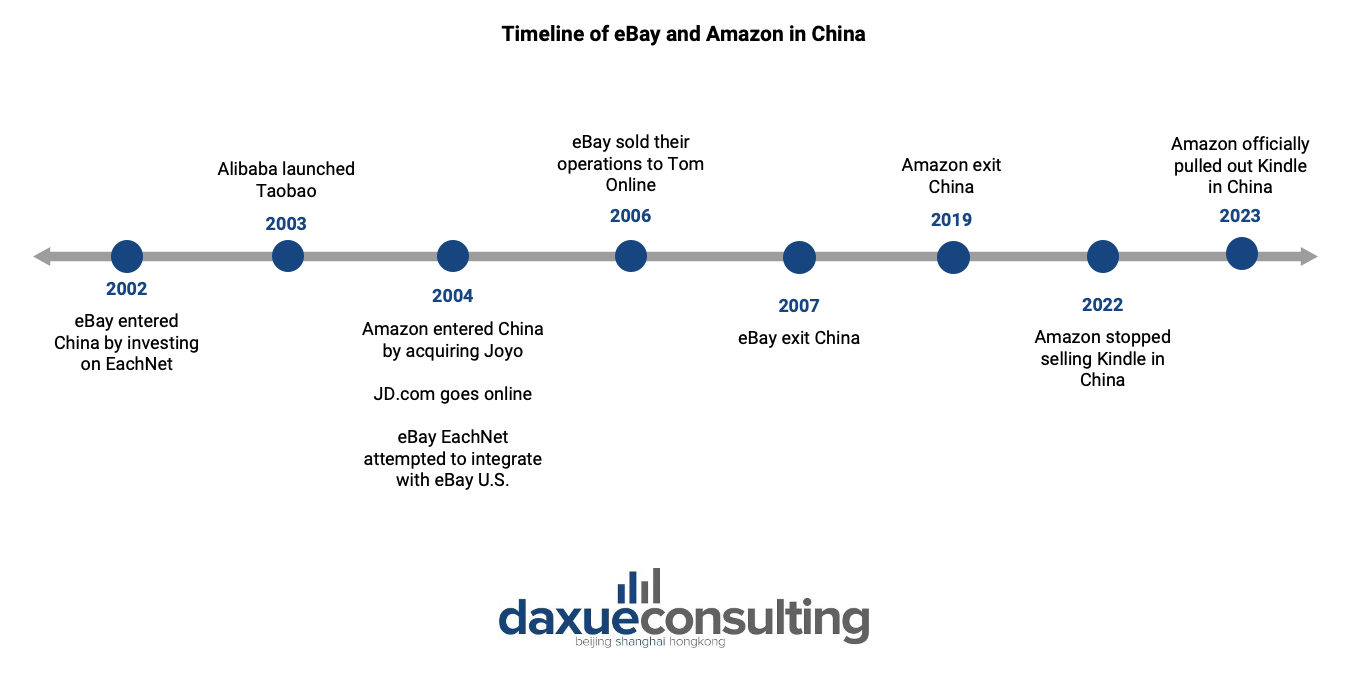Amazon and eBay are household names across the world. Amazon, which initially started as a bookstore, made its name as a global e-commerce giant that changed the landscape of online retail. eBay, on the other hand, became synonymous with online auctions and provided a platform for entrepreneurs and small businesses to reach a worldwide audience over the years. In the early 2000s, the prospect of tapping into the vast Chinese market lured these two giants. However, what awaited them was a challenging landscape, shaped by dominant local players, unique consumer behaviors, and intricate cultural nuances.
Download our US consumer segmentation report

eBay and Amazon both tapped into the Chinese market by M&A
Between 1999 and 2000, homegrown e-commerce platforms emerged in China, leveraging mass internet adoption and reshaping the market. The SARS epidemic in 2002-2003 accelerated the growth of B2C e-commerce, leading to innovations by companies like JD and Alibaba. In 2004, the Chinese government’s Electronic Signature Law provided legal backing, legitimizing online transactions. It is around this time that both Amazon and eBay decided to enter the developing Chinese e-commerce market.
In 2002, eBay entered China by investing USD 30 million to purchase a 33% stake in EachNet, a prominent Chinese auction platform. By then, EachNet already had an impressive 3.5 million registered users and held 95% share of the Chinese online C2C market. In 2003, eBay expanded its ownership of EachNet to full control. However, despite initial optimism, eBay opted to cease its operations in China in December 2016.
Much like eBay, Amazon made its entry into the Chinese market through an acquisition a couple of years later. In a move reminiscent of its origins as an online bookstore, Amazon acquired the local online bookseller Joyo for a substantial USD 75 million in 2004. This strategic maneuver enabled Amazon to establish a firm presence in such big market. Joyo Amazon was then rebranded as Amazon China in 2011 into Amazon China, signifying a crucial phase in the company’s global expansion efforts. Despite an initial market share of around 15% between 2011 and 2012, Amazon’s presence dwindled drastically to less than 1% by 2015.
Alibaba and JD: The leading players in the Chinese e-commerce
In the ever-evolving Chinese e-commerce scene, Alibaba and JD have cemented their positions as the primary powerhouses, a legacy that originated in the industry’s infancy and continues unchallenged. Alibaba first created Taobao not long after eBay entered China to compete with the US company in 2003. A year later, JD opened its e-commerce platform around the time Amazon entered China in 2004. These two giants managed to snatch and maintain a significant amount of market share.
A report from the International Trade Administration in 2023 reveals that in terms of GMV, Alibaba holds a staggering 49% market share, underscoring its pivotal role in shaping China’s online retail landscape. Its market valuation is also far in the lead with an astounding RMB 1.5 billion as of 2022 followed by JD.com with RMB 630 million.

Understanding Chinese consumer preferences
In order to successfully enter a new market, a deep understanding of local consumer behavior is crucial. Both Amazon and eBay failed to conquer the Chinese market as they did not manage to fully tailor their products to align with the specific features and preferences valued by Chinese consumers.
Chinese consumers are known for their keen sensitivity to prices
Chinese consumers are highly price-sensitive. Yet, successfully conquering this vast consumer base could lead to unparalleled success, transforming businesses into billion-dollar enterprises. Local players in China recognize this potential and are willing to incur substantial losses, millions of dollars, with the strategic goal of capturing the market’s loyalty. However, Amazon and eBay fell short in this arena. In 2001, Jeff Bezos introduced the “flywheel theory,” aiming to attract customers with lower prices, increase sales, and enhance profits. He believed a good reputation could reduce marketing costs, enabling lower prices and improved customer experience. However, this approach didn’t account for the complexities of the Chinese market. Amazon’s decision to avoid sales promotions and price wars resulted in declining market share, as the company focused on its core values amidst intense competition.
Customer services and human touch is crucial for Chinese consumers
Another critical aspect where Amazon and eBay fell short was their lack of customer chat support. While Amazon excelled in creating a seamless user experience and understanding user behavior, they lacked the crucial human touch – the ability to connect users with real people for assistance. In contrast, their Chinese competitors recognized the strong preference of Chinese consumers of this direct engagement and were willing to invest substantially in labor-intensive customer service.
Cultivating community to reach e-commerce success
Chinese consumers also highly appreciate a sense of community and personalized service. Brands ranging from low-end to luxury levels generally have WeChat groups where people can see what the brand is offering and discuss it with each other. This community-driven approach, although people-intensive and manual, resonates deeply with Chinese consumers. Local businesses understand the power of these close-knit connections, providing yet another dimension where Amazon and eBay missed the mark.
Utilizing a one-size-fits-all approach
Both Amazon and eBay tried to adapt their established business models from the United States and other Western countries to the Chinese market. Beyond the strategies previously outlined, both companies employed additional tactics to establish their presence in the Chinese market.
eBay’s strategy in China
Advertisement
In a bid to dominate the Chinese market, eBay aggressively launched campaigns to thwart competitors, including signing exclusive advertising deals with major portals such as Sina, Sohu, and Netease to block Taobao’s advertisement. The US company invested additional USD 100 million to its China operations, dubbed as “eBay EachNet”, to put advertisements on public places.
Business model
eBay EachNet charged sellers for listings and transactions, with a significant emphasis on auction-based sales, accounting for 40% of their listings. However, this approach faced criticism for being product-centric rather than customer-centric. The platform lacked flexibility in listing periods and did not cater to mobile-savvy users.
Payment system
In October 2022, eBay acquired PayPal for USD 1.2 billion. eBay users were restricted to payment options such as PayPal, credit cards, and a few local bank debit cards, with limited availability for online banking. Meanwhile during that time, Alipay was the most popular payment method in China. This limited payment flexibility discouraged consumers from making purchases on the platform.
Amazon’s strategy in China
Management structure
Amazon China followed a centralized approach, operating under the control of its global headquarters, leading to limited autonomy in management. The president of Amazon China had limited authority, particularly in areas like operations and logistics, which were managed by the U.S. headquarters. This lack of autonomy and overreliance on Western management practices hindered Amazon’s ability to capture a substantial share of the Chinese market.
Logistics
While Amazon China established a state-of-the-art logistics operation network in the country, the overall development was still lacking. This is due to several reasons. While Amazon’s logistics network extended to first and second-tier cities, the third and fourth-tier cities relied on third-party logistics, diminishing control and customer satisfaction. Moreover, Chinese consumers required faster deliveries than Americans, and high logistics costs coupled with slow goods circulation posed challenges for Amazon’s sustainability.
UX Design
Amazon, like many Western platforms, opts for a minimalist UX design for its marketplace. Yet, local consumers prefer shopping websites that has a lot of details and intricate designs like what the Chinese platforms do. Moreover, Chinese e-commerce platforms emphasize detailed product descriptions, multiple channels for understanding products, and interactive features like online customer service and buyer shows.
eBay’s China retreat and Amazon’s cross-border shift
In October 2004, eBay EachNet attempted to integrate its platform with eBay U.S., aiming to facilitate cross-border trading between China and the U.S. However, the migration led to a significant drop in traffic due to slow internet infrastructure and government-imposed restrictions. The move also halted development for a year, hindering improvements. During this period, Taobao gained popularity, capturing 60% of the market share within six months. Despite attempts to recover, eBay EachNet’s market share dwindled to 7% by mid-2007. In 2006, eBay sold its China operations to Tom Online, marking an unsuccessful venture despite a substantial investment of nearly USD 300 million.
In 2019, Amazon strategically withdrew from China’s domestic online retail market, pivoting its focus towards cross-border e-commerce. Through this cross-border e-commerce, Chinese merchants can join Amazon’s global platform to sell their products internationally. Amazon retained its Kindle and cloud computing services in the country, and the company redirected its efforts towards expanding in other markets, with a significant emphasis on long-term growth in India. However, in June 2023, Amazon ceased its Kindle services in China, indicating a reevaluation of its presence in the Chinese market.

eBay and Amazon’s missteps in the Chinese market
- In the early 2000s, both eBay and Amazon entered China through acquisition. Amazon acquired Joyo.com, eBay invested in EachNet.
- Alibaba’s Taobao and JD.com emerged as dominant players, capturing significant market share and becoming integral to China’s e-commerce landscape.
- Chinese consumers are highly price-sensitive which resulted in aggressive pricing that eBay and Amazon in China are unable to match.
- Chinese consumers also value personalized customer service and community engagement. Local platforms excelled in providing a human touch, whereas eBay and Amazon in China lacked direct customer engagement.
- Both eBay and Amazon withdrew from the Chinese market in 2006 and 2019, respectively, mainly because they couldn’t adapt to local preferences and capture a significant market share.





